Table of Contents
- Introduction
- Previous Magnifiers
- Coil 8277 ATMax
- Coilcraft Free Magnifier
- Edmund Optics 35359 10x Magnifier and BelOMO Triplet
- Donegan OptiVISOR
- Carson MG-88 MagniGrip 4.5x Magnifier with LED and Tweezers
- Carson 2.5X CrystalView Aspheric Magnifier with 5x Spot Lens
- Carson Lume Series COB LED 2.5X Magnifier with 7x Spot Lens
- Carson 5x 2.5" Aspheric Magnifier SV-50
- Other Recommendations
- Summary
Introduction
Since none of us are getting younger, we eventually need to consider how to see small parts in the electronics engineering world. There are thousands of options, including handheld magnifiers, microscopes and video cameras. Even a mobile phone can be effective to view things close-up.
Over the years, I've tried quite a few magnifiers, ranging from a cost of free to perhaps $100, and the main use-cases have been to be able to read surface-mount component part numbers, inspecting solder joins looking for shorts, and for aiding me to solder small parts with an iron. For this blog post, I won't cover the previous magnifiers again, but I will look at some additional ones I've tried in the past few years.
From the previous magnifiers, the most outstanding one was made by UltraOptix. It has lasted more than 5 years, survived a couple of battery leaks, and the image quality and the LED light quality is good. Furthermore, it's really low-cost (under $10). The only disadvantage is availability; it is cheap and easily available in the US, but in the UK it is a bit harder to obtain, there are just a few sellers on Amazon, and they charge more.
This shoot-out covers:
- Coil 8277 ATmax
- Coilcraft Freebie
- Edmund Optics 35359 10x Magnifier
- BelOMO 10x Triplet
- Donegan OptiVISOR DA-4 2x Head Mount MagnifierDonegan OptiVISOR DA-4 2x Head Mount Magnifier
- Carson MG-88 MagniGrip 4.5x Magnifier with Tweezers
- Carson CrystalView 2.5x Aspheric Magnifier with 5x Spot Lens
- Carson Lume Series COB LED 2.5x Aspheric Magnifier with 7x Spot Lens
- Carson 5x 2.5" Lighted Aspheric Magnifier SV-50
From the magnifiers examined here, the best ones were the OptiVISOR, and the Carson 2.5X handheld magnifiers (CrystalView and Lume), which come in illuminated and non-illuminated options.
There is a 15-minute video that attempts to show what it is like looking through each magnifier.
Previous Magnifiers
From an earlier blog post Building a Digital PCB Inspection Microscope with the Gizmo 2 , the photo here shows UltraOptix 7x Aspheric 1.5 inch LED Lighted Magnifier along with others not really worth mentioning. The UltraOptix is very good for examining part markings, and it is very low-cost.
Coil 8277 ATMax
This magnifier was quite expensive, and performed poorly from my perspective. This is a 7X magnifier made from a biconvex lens, with a touch-sensitive built-in LED light, and contains two AA batteries. It comes with a storage bag.
The magnification is quite high (7X) which in part makes it harder to accurately position, although the far cheaper UltraOptix magnifier (with better aspheric lens rather than biconvex) managed just fine. With the ATmax magnifier, everything is heavily distorted, and there's plenty of colour fringing anywhere off-center too. There are also lots of reflections off room lighting. Also, I have encountered situations where the touch-sensitive light would stay on even though the magnifier was placed on a desk, so it's not completely reliable. The only positives are that the device is constructed nicely and its very ergonomic with the rubbery grip.
The photo below shows it centered on a SOT-23 component. Everything else is distorted.
Coilcraft Free Magnifier
Buying a Coilcraft inductor kit results in receiving a free magnifier inside the box : ) It's actually not bad, I have several of these now, and they are quick to use with their plastic stand. They are good enough to read part markings. This style of foldaway magnifier is usually known as a Linen Tester or Linen Magnifier.
Edmund Optics 35359 10x Magnifier and BelOMO Triplet
A loupe can be quite handy to read part markings. They are intended to be used with the eye close-up, and this particular one would only be of use if you can get your head close to the object to be inspected. Despite being close to the object, the eye still focuses at a distance, and therefore there is no eye strain.
The image quality with the Edmund Optics magnifier is great with no distortion (see the photo below, but when actually using it, it is possible to position it so that the entire board is clear without the white blur visible in the photo), however the room needs to be well-lit, otherwise the loupe and your head will block out light. I think an illuminated loupe would be a better idea.
The earlier photo also another loupe, called BelOMO Triplet, which is a bit too small I feel. I keep it on a neck-strap, but I don't use it often, it suffers from the same issue that good lighting is needed.
Donegan OptiVISOR
The OptiVISOR OptiVISOR is one of my favorite magnifiers – it's simply brilliant. This head-mounted magnifier can be worn for hours without tiredness. It can be easily swung up when normal vision is needed. I like positioning it such that I can look down and have normal vision, or raise eyes to look through the lenses; that way, I don't need to frequently swing the lenses up and down.
This magnifier can be used for soldering. Objects are in focus approximately 6 inches away from the end of the magnifier, and so although you'll need to bring your head in while soldering, it's not uncomfortable.
Different strength lenses can be fitted. Mine came with number 4 lenses, they seem fine.
This magnifier could single-handedly make the difference between being able to do surface-mount work, and not being able to do it, if you're no longer blessed with perfect vision.
The photo below was taken with the OptiVisor placed in front of the camera; the field of view when actually wearing it is just slightly more than the width of a Raspberry Pi.
Carson MG-88 MagniGrip 4.5x Magnifier with LED and Tweezers
These tweezers have an LED attached to one arm of tweezers, and a combined watch battery compartment and twist switch at the back of the device. The magnifier is on a long arm hinged at the joint.
I really wanted to like this product, but despite the magnifier itself being semi-reasonable, the other parts of it were a let-down; the tweezers are not really intended for precise work with electronics, this is not their target market. The tweezers are hard to squeeze and are not made with the accuracy needed for electronics. I don't think they could be improved with a bit of DIY either; the entire tweezers would need replacing. The length is too short too – I expect tweezers to be about 120 mm long, but these ones are barely 100 mm long, and the battery section falls into the palm on the hand. I don't know how long the three L926F watch batteries would last.
Carson 2.5X CrystalView Aspheric Magnifier with 5x Spot Lens
This magnifier is physically large, does its job, and is low-cost (about £10) – it's excellent. It comes with a sock to protect the lens portion.
The lens is plastic and aspheric. The image quality is great, with no noticeable distortion when using it. It can be placed about 5 inches away from the circuit board, and so it is feasible to solder using this magnifier, provided it can be clamped in position. I used a DIY clamp: Building Custom Helping Hands
Carson Lume Series COB LED 2.5X Magnifier with 7x Spot Lens
This magnifier has thee diffused LEDs spaced around the edges, and the power switch provides two brightness settings. It takes two AAA batteries.
The image quality from the plastic aspheric lens is very good. It is possible to perform soldering work with this magnifier provided it can be clamped into position.
I also liked the smaller 7X lens next to the power switch, it is useful if extra magnification is briefly needed to read part markings. The LED lighting is effective for that too, since the light arrives at a shallow angle, which works well with etched markings to provide good contrast.
Carson 5x 2.5" Aspheric Magnifier SV-50
This magnifier is quite a decent size, with an approx. 50 mm diameter lens. It's aspheric, so the image quality is decent, but it's not to the same standard as the image quality from the larger diameter 3x magnifiers mentioned above (Carson Lume and Carson CrystalView). The image has some distortion in the outer 30% or so of the image, but it's not anywhere near as bad as the Coil 8277. It's very usable.
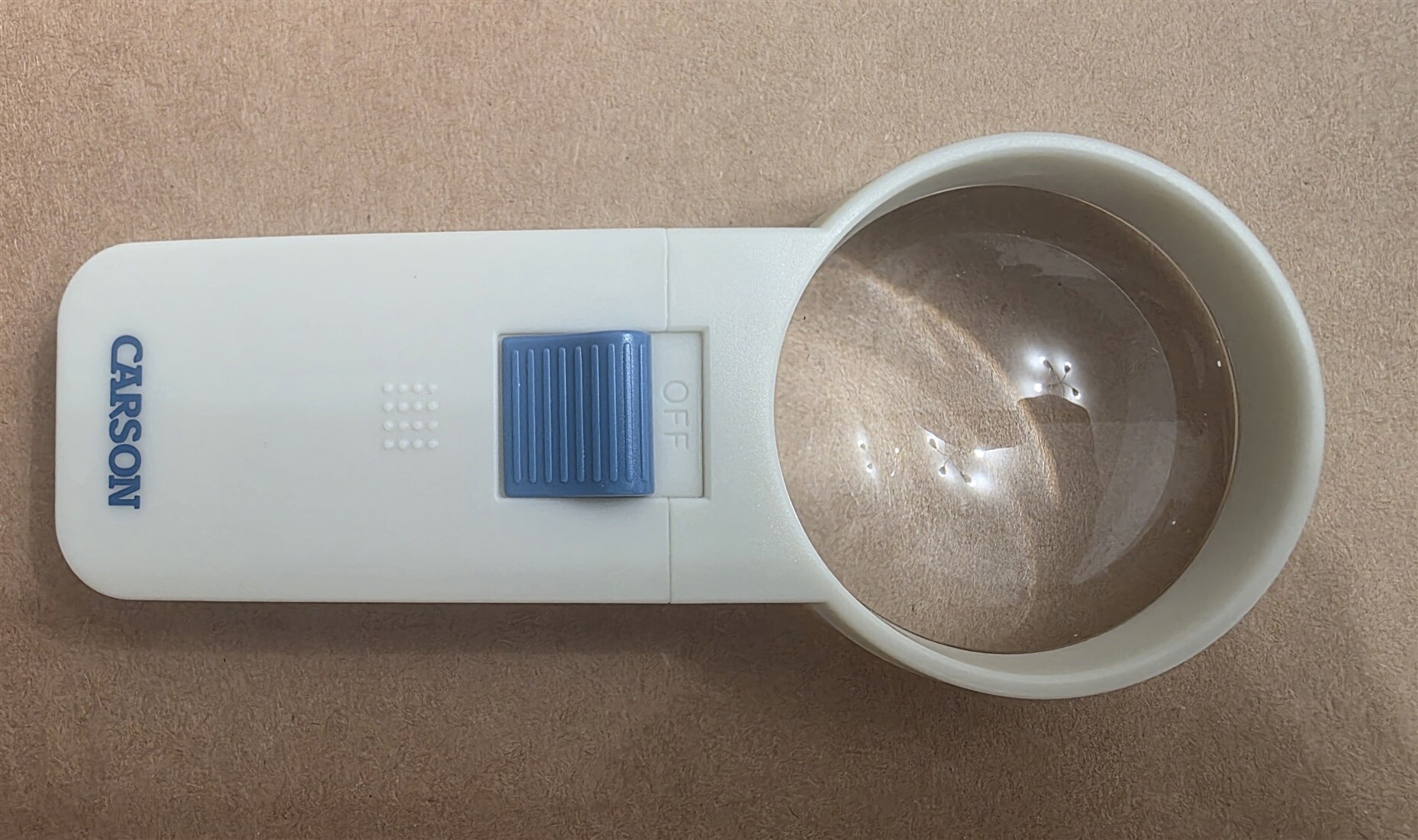
The LED illumination is quite a nasty cold white, but it gets the job done.
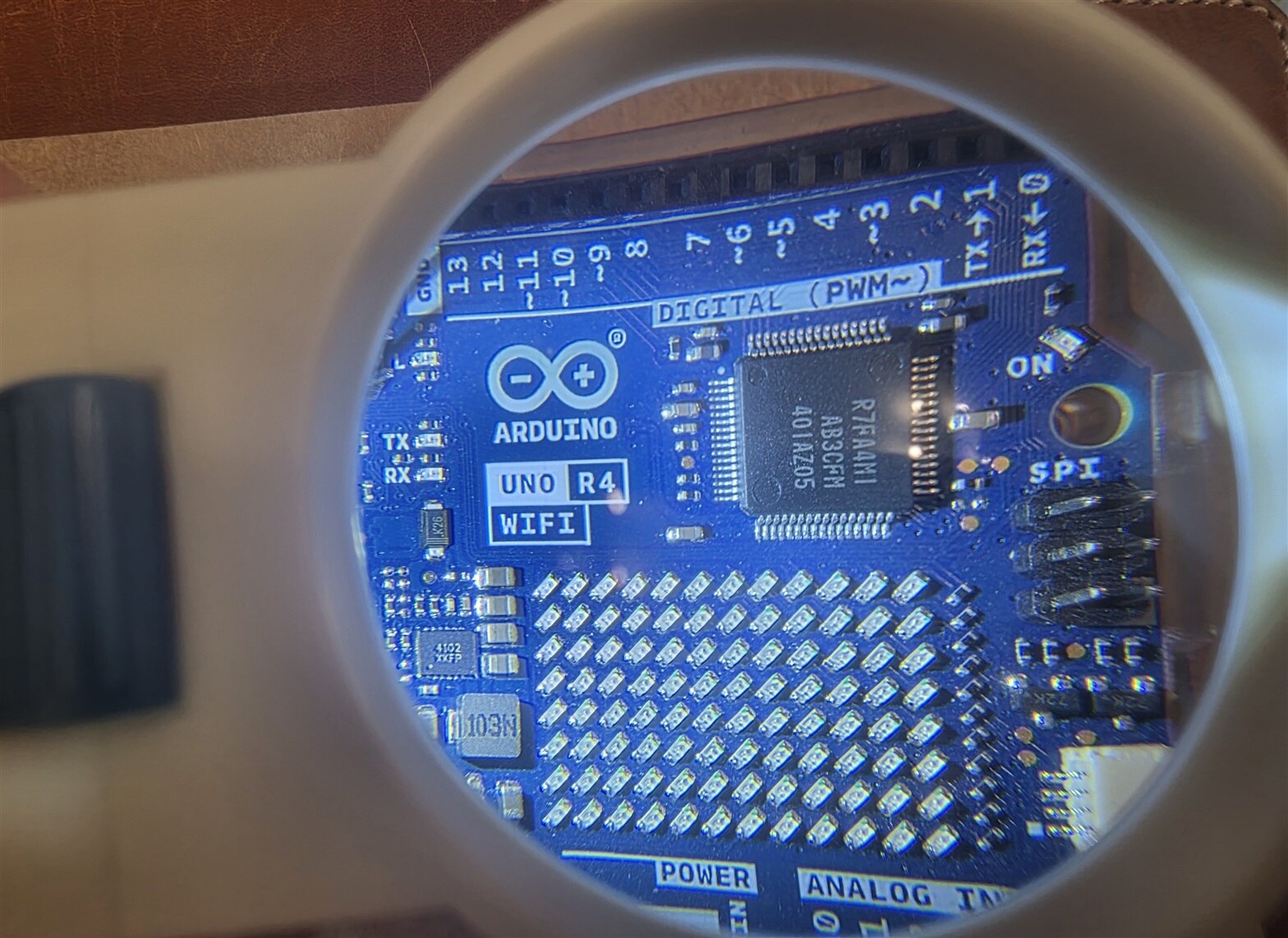
There is some glare from the LED, but it's not too bad.
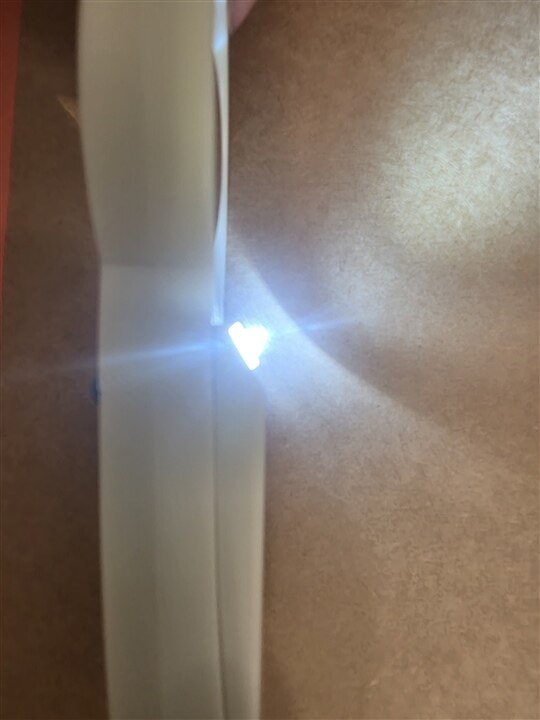
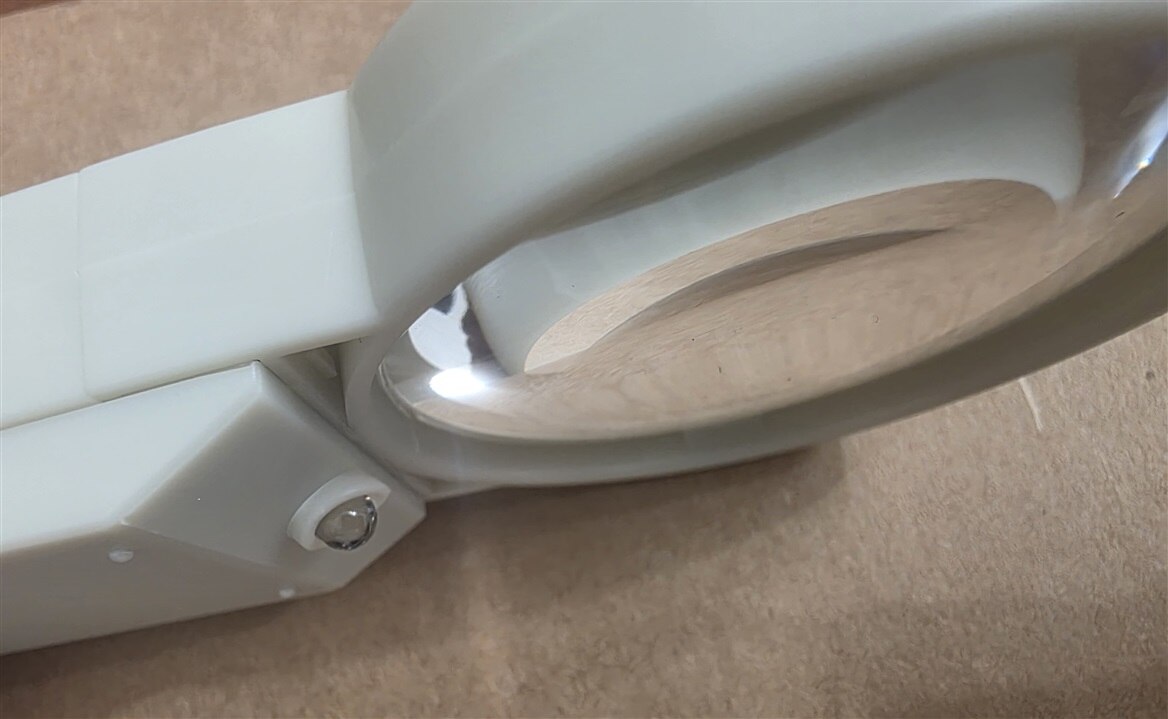
Inside, three AAA batteries are required (not supplied) and they should last a very long time since there's only one LED to light up. From experience with the physically smaller 7x version of this product, I can confirm that the slide switch will last for many years in normal use.
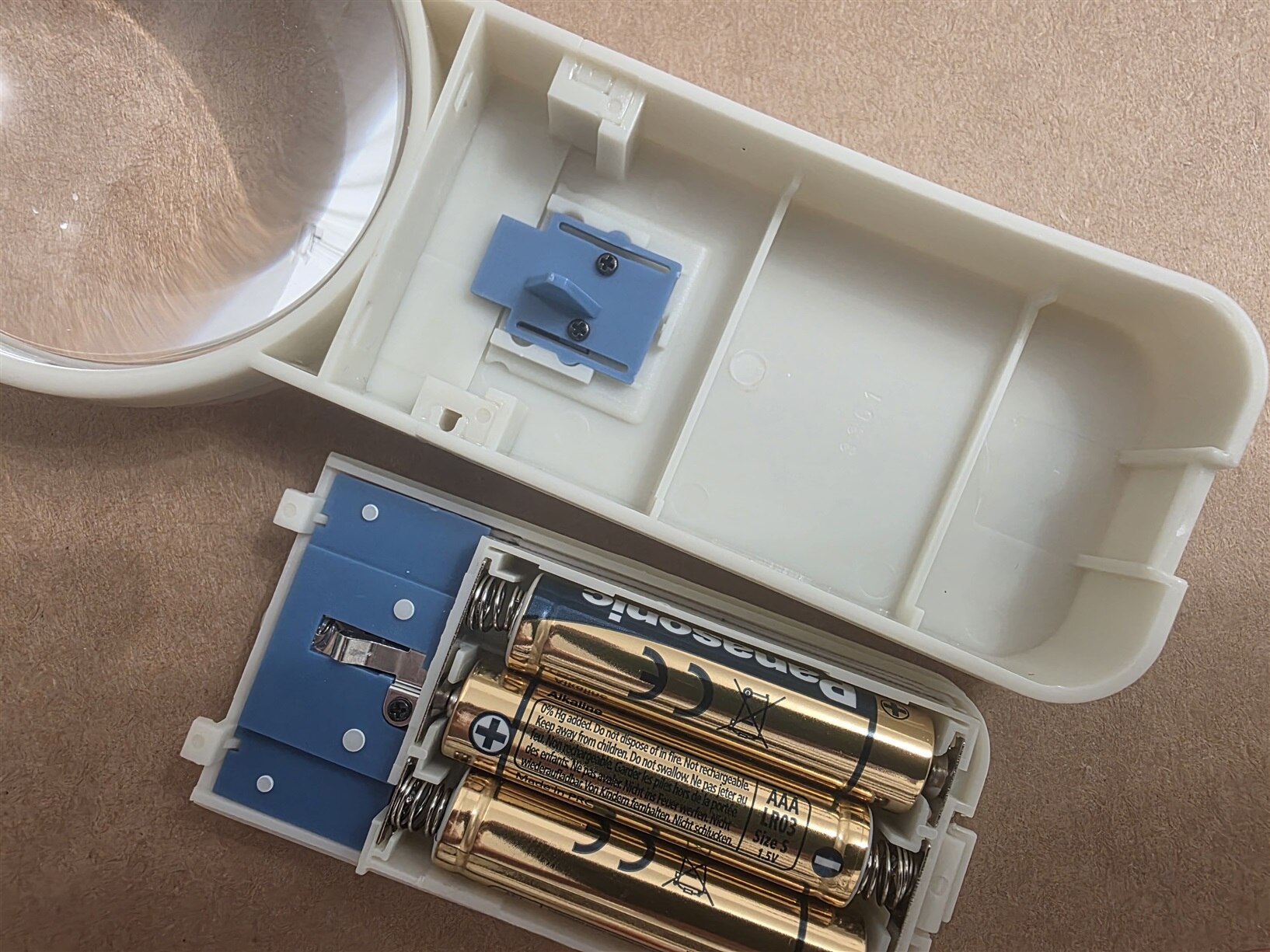
Overall, it's not a bad product, it gets harder to find decent 5x magnifiers at good prices, and this one is for sure usable.It doesn't come with a protective pouch, but the lens won't hit the desk easily, because it is protected by the deep plastic rim.
Other Recommendations
If you have any favorite magnifiers, it would be great to learn about them, since there may be excellent ones that I don't know about. It would be very useful information - saves people spending on poor-performing magnifiers!
Summary
The table here shows my conclusions. Thanks for reading!
| Magnifier Name | Conclusion | Cost (GBP or USD) |
|---|---|---|
| UltraOptix 7x Aspheric 1.5 inch LED Lighted Magnifier | Excellent image quality, good built-in LED light, extremely low cost | $9.95 |
| Coil 8277 ATmax | Awful image quality with heavy distortion and color fringing. Comes with a zip-up cover. | £55 |
| Coilcraft Freebie | Very usable for reading part markings | $0 with any inductor kit (or maybe ask them nicely?) |
| Edmund Optics 35359 10x Magnifier | Excellent image quality, but needs good lighting because your head will block the light | £25 |
| BelOMO 10x Triplet | Excellent image quality, but same issue as the Edmund Optics magnifier | £35 |
| Donegan OptiVISOR DA-4 2x Head Mount Magnifier | Excellent image quality, and ideal for soldering surface-mount components | $43 |
| Carson MG-88 MagniGrip 4.5x Magnifier with Tweezers | Great image quality, but poor tweezers for engineering purposes (fine for beauty work I expect!) | £12 |
| Carson CrystalView 2.5x Aspheric Magnifier with 5x Spot Lens | Excellent image quality, and good depth for soldering, provided it can be clamped in position. Comes with a sock/cover. | £10 |
| Carson Lume Series COB LED 2.5x Aspheric Magnifier with 7x Spot Lens | Excellent, as good as the Carson CrystalView, but has really great LED lighting too (with two brightness levels). Doesn't come with a cover. | £15 |
| Carson 5x 2.5" Aspheric Magnifier SV-50 | Good image quality, but could be better. Large 50mm diameter lens. Has an LED light that should last a long time. | £15 |















Top Comments
-

beacon_dave
-
Cancel
-
Vote Up
+1
Vote Down
-
-
Sign in to reply
-
More
-
Cancel
Comment-

beacon_dave
-
Cancel
-
Vote Up
+1
Vote Down
-
-
Sign in to reply
-
More
-
Cancel
Children